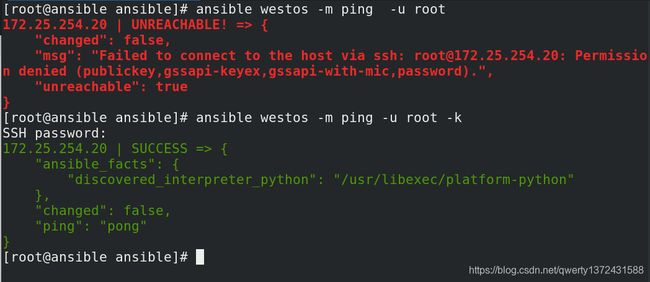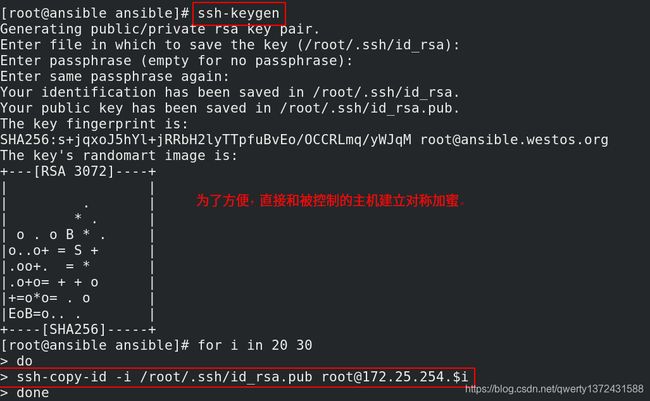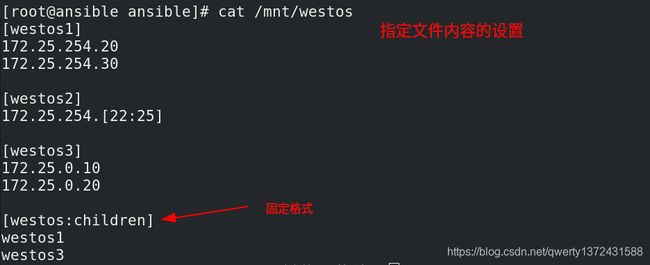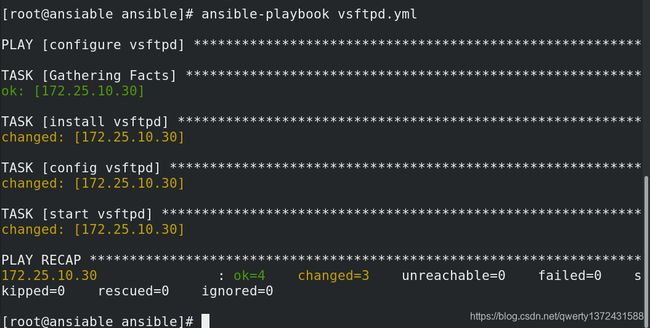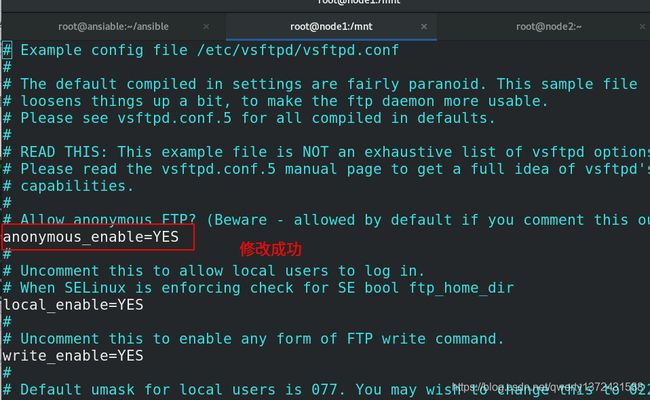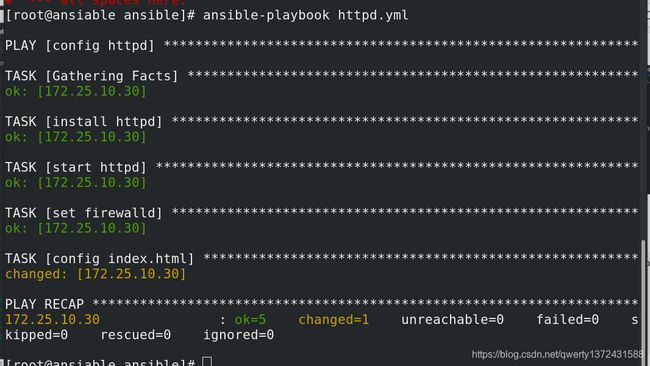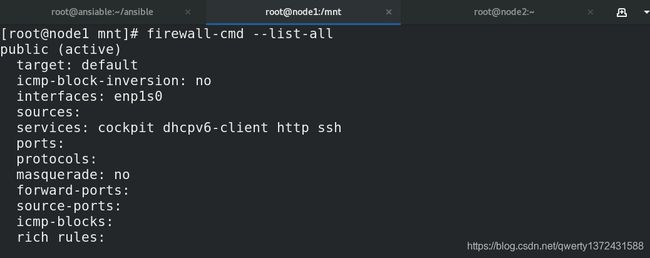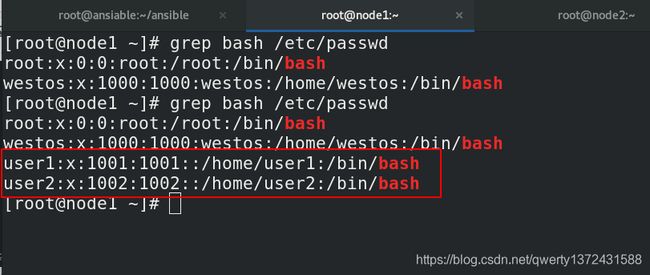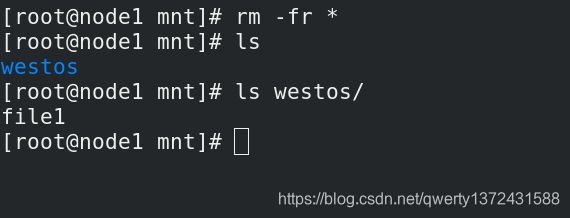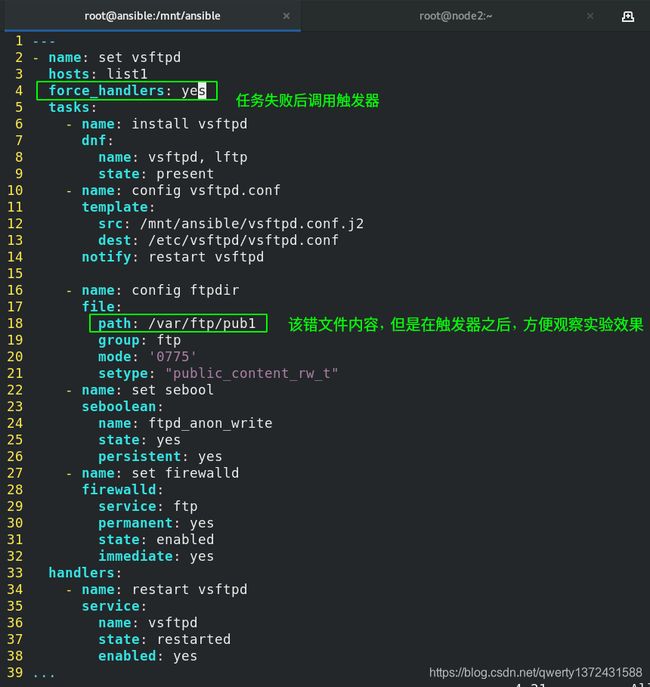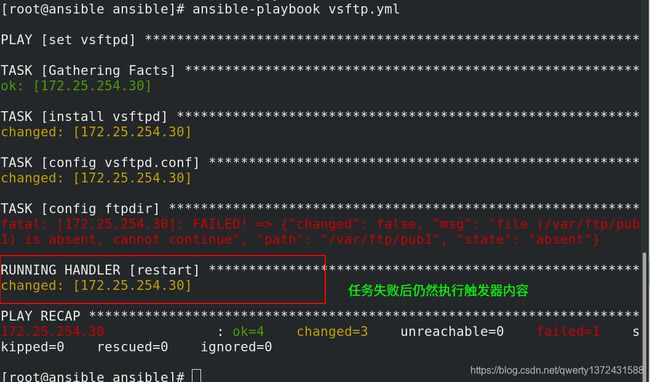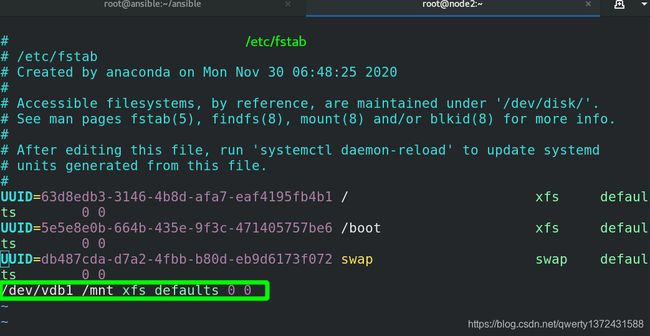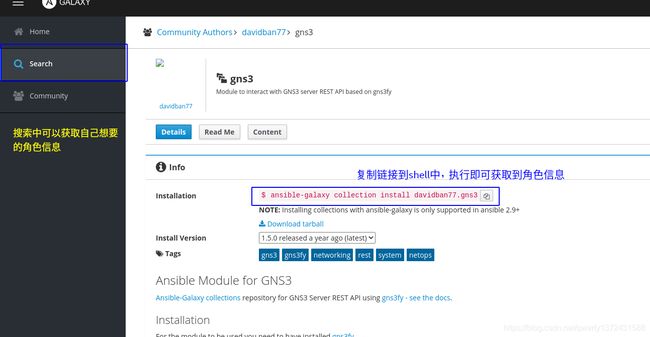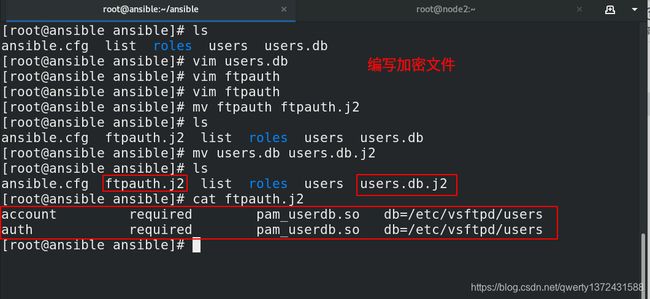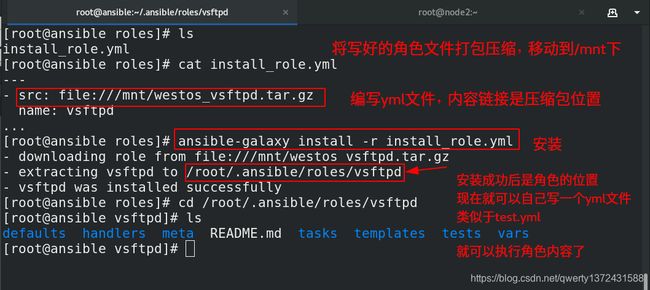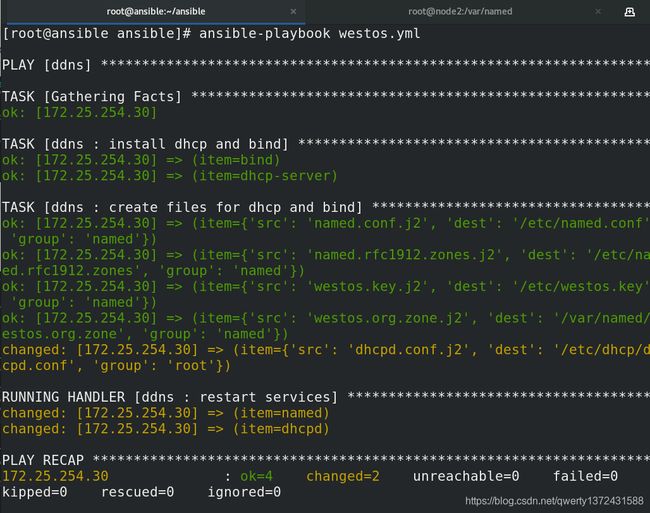ansible学习
Ansible学习
- 1 ansible 原理与环境搭建
-
- 1.1 Ansible对于企业运维的重大意义
- 1.2 Ansible的安装
- 1.3. 前期环境的配置
- 1.4 清单介绍
- 1.5 Ansible配置文件参数详解
- 2 ansible常见模块合集
-
- 2.1 ansible实现管理的方式
- 2.2 Ad-Hoc执行方式中如何获得帮助
- 2.3. ansible命令运行方式及常用参数
- 2.4.ansible的颜色含义
- 2.5 常用模块
-
- 2.5.1 command
- 2.5.2 shell 模块
- 2.5.3 script模块
- 2.5.4 copy模块
- 2.5.5 fetch模块
- 2.5.6 file
- 2.5.7 unarchive模块
- 2.5.8 archive
- 2.5.9 hostname
- 2.5.10 cron
- 2.5.11 yum_repository
- 2.5.12 dnf
- 2.5.13 service
- 2.5.14 user
- 2.5.15 group
- 2.5.16 lineinfile
- 2.5.17 replace
- 2.5.18 setup
- 2.5.19 debug
- 2.5.20 seboolean
- 2.5.21 filesystem
- 2.5.22 mount
- 2.5.23 parted
- 3 playbook
-
- 1.1 Playbook的功能
- 1.2 YAML
- 1.3 YAML 列表
- 1.4 YAML的字典
- 1.5 playbook执行命令
- 1.6 Playbook的核心组件
- 1.7 基本示例
- 1.8 vim 设定技巧
- 4 ansible变量使用
-
- 4.1 变量命名
- 4.2 变量级别
- 4.3 变量设定和使用方式
-
- 4.3.1 在playbook中直接定义变量并使用变量
- 4.3.2 在文件中定义变量
- 4.4 设定主机变量和清单变量
- 4.5 目录设定变量
- 4.6 用命令覆盖变量(本身没变量也会被覆盖)
- 4.7 使用数组设定变量
- 4.8 注册变量
- 4.9 事实变量
- 4.10 魔法变量
- 4.11 JINJA2模板
- 4.12 j2模板在playbook中的应用
- 4.13 Ansible的加密控制
- 5 ansible 控制流语句
-
- 5.1 循环
-
- 5.1.1 简单循环
- 5.1.2 循环散列或字典列表
- 5.2 条件
- 5.3 触发器
- 5.4 处理失败任务
-
- 5.4.1 ignore_errors
- 5.4.2 force_handlers
- 5.4.3 changed_when
- 5.4.4 failed_when
- 5.4.5 block(注意格式)
- 6. ansible roles
-
- 6.1 roles简介
- 6.2 roles目录结构
- 6.3 role存放的路径在配置文件ansible.cfg中定义
- 6.4 创建目录结构
- 6.5 playbook中使用roles
- 6.6 控制任务执行顺序
- 6.7 ansible—galaxy命令工具
- 6.8 安装选择的角色
- 6.9 综合练习
1 ansible 原理与环境搭建
1.1 Ansible对于企业运维的重大意义
- 将多台主机的控制集中到一台,通过shell设置好,集中控制。
- ansible是新出现的自动化运维工具,基于Python开发,集合了众多运维工具(puppet、cfengine、chef、
- func、fabric)的优点,实现了批量系统配置、批量程序部署、批量运行命令等功能。
- ansible是基于模块工作的,本身没有批量部署的能力。真正具有批量部署的是ansible所运行的模块,
- ansible只是提供一种框架。
1.2 Ansible的安装
- epel源
- dnf install ansible -y
- ansible --viersion
- ansible的基本信息:
- /etc/ansible/ansible.conf ##全局配置文件,默认很少修改
- /etc/ansible/hosts ##全局主机清单清单文件
1.3. 前期环境的配置
- 一台ansible服务器(172.25.254.110)
- 两台受控主机(网段分别为172.25.254.20、172.25.254.30)
- ansible主机的设定
如果电脑卡就关掉图形界面,使用无图形界面!!
配置完毕!!!
- 配置受控主机172.25.254.20、172.25.254.30
主机名分别为node1.westos.org、node2.westos.org
1.4 清单介绍
- /etc/ansible/hosts ##控制默认清单列表位置
- 清单写主机名或者ip都可以,每行一个
- node1.westos.com
- node2.westos.com
- 172.25.254.20
- 清单查看:
- ansible westos --list-hosts ##显示westos列表中的ip
- ansible westos1 --list-hosts ##显示westos1列表中的ip
- ansible ungrouped --list-hosts ##显示没有分组的列表ip
- ansible all --list-hosts ##显示所有分组列表内容
- 清单形式:
- #单层清单#
- [list1]
- node1.westos.com
- node2.westos.com
- [list2]
- node2.westos.com
- [list3]
- 172.25.254.240
- #嵌套清单#
- [westos:children] ##格式必须对
- list1
- list3
- #主机规格的范围化操作
- ##通过指定主机名称或IP的范围可以简化Ansible主机清单
- #语法:
- #[start:end]
- 示例:
- [westostest]
- 172.25.254.[100:108]
- #ansible命令指定清单的正则表达式(匹配已有的清单列表)
- * ##所有
##172.25.254.*
##westos*
示例
ansible 'westos*' -i /mnt/westos --list
ansible '172.*' -i /mnt/westos --list
- : ##逻辑或
##:westos1:linux:
##172.25.254.100:172.25.254.200
示例
ansible 'westos_list1:westos_list2' -i /mnt/westos --list
- :& ##逻辑与
##"westos1:&linux"
##主机即在westos1清单也在linux清单
示例
ansible 'westos_list2:&westos_list3' -i /mnt/westos --list
- :! ##逻辑非
##'westos1:!linux'
##在westos1中不在linux中
示例
ansible 'westos_list2:!westos_list3' -i /mnt/westos --list
- ~ ##以关键字开头,执行优先级高
~(str1|str2) ##以条件1或者条件2开头
示例
ansible '~westos' -i /mnt/westos --list
ansible '~list:!westos' --list-hosts -i /mnt/westos
ansible '~list:westos' --list-hosts -i /mnt/westos
ansible '~list:&westos' --list-hosts -i /mnt/westos
-
-
- ansible westos -m ping -u root -k ##通过密码输入,来ping通westos列表中的用户ip。m表示执行指令
- ansible westos --list-hosts -i /mnt/westos ##i指定列表文件
-
正则表达式测试
1.5 Ansible配置文件参数详解
- 1. 格式
- ansible 清单中组名称 -m 模块 -u remote_user(远程主机用户)
- 2. 配置文件的分类与优先级
- /etc/ansible/ansible.cfg #基本配置文件,找不到其他配置文件此文件生效
- ~/.ansible.cfg #用户当前目录中没有ansible.cfg此文件生效
- ./ansible.cfg #优先级最高
- 3. 常用配置参数
- #[default] ##基本信息设定
- inventory= ##指定清单路径
- remote_user= ##在受管主机上登陆的用户名称,未指定使用当前用户
- ask_pass= ##是否提示输入SSH密码,如果公钥登陆设定为false
- library= ##库文件存放目录
- local_tmp= ##本机临时命令执行目录
- remote_tmp= ##远程主机临时py命令文件存放目录
- forks= ##默认并发数量
- host_key_checking= ##第一次连接受管主机时是否要输入yes建立host_key
- sudo_user= ##默认sudo用户
- ask_sudo_pass= ##每次在受控主机执行ansible命令时是否询问sudo密码
- module_name= ##默认模块,默认使用command,可以修改为shell
- log_path= ##日志文件路径
- #[privilege_escalation] ##身份信息设定
- become= ##连接后是否自动切换用户
- become_method= ##设定切换用户的方式,通常用sudo
- become_user= ##在受管主机中切换到的用户,通常为root
- become_ask_pass ##是否需要为become_method提示输入密码,默认为false
local_tmp= ##本机临时命令执行目录
remote_tmp= ##远程主机临时py命令文件存放目录
remote_user= ##在受管主机上登陆的用户名称,未指定使用当前用户



ansible是新出现的自动化运维工具,基于Python开发,集合了众多运维工具(puppet、cfengine、chef、func、fabric)的优点,实现了批量系统配置、批量程序部署、批量运行命令等功能。
ansible是基于模块工作的,本身没有批量部署的能力。真正具有批量部署的是ansible所运行的模块,ansible只是提供一种框架。
![]()
[privilege_escalation] ##身份信息设定
- 远程需要在系统及文件夹或者需要修改没有权限的文件,就需要设定身份信息,可以直接以root用户身份执行。
 (此处的10.20,10.30和254.20,254.30一样)
(此处的10.20,10.30和254.20,254.30一样)

2 ansible常见模块合集
2.1 ansible实现管理的方式
- Ad-Hoc ##利用ansible命令直接完成管理,主要用于临时命令使用场景
- playbook ##ansible脚本,主要用于大型项目场景,需要前期的规划
2.2 Ad-Hoc执行方式中如何获得帮助
- ansible-doc ##显示模块帮助的指令
- #格式
- ansible-doc [参数] [模块...]
- #常用参数
- -l ##列出可用模块
- -s ##显示指定模块的playbook片段
![]()
![]()
2.3. ansible命令运行方式及常用参数
- #格式:
ansible 清单 -m 模块 -a 模块参数
- #常用参数
--version ##显示版本
-m module ##指定模块,默认为command模块
-v ##详细过程 -vv -vvv更详细过程
--list ##显示主机列表,也可以用--list-hosts
-k ##提示输入ssh连接密码,默认key认证
-C ##预执行检测
-T ##执行命令的超时时间,默认10s
-u ##指定远程执行的用户
-b ##执行sudo切换身份操作(相当于ansible.cfg中的become参数)
-become-user=USERNAME ##指定sudo的用户
-K ##提示输入sudo密码(相当于ansible.cfg中的become_ask_pass参数)
![]()
![]()
![]()
2.4.ansible的颜色含义
- 绿色 ##执行成功但没有对远程主机做任何改变
- 黄色 ##执行成功并对远程主机做改变
- 红色 ##执行失败
![]()
2.5 常用模块
2.5.1 command
- #功能: 在远程主机执行命令,此模块为默认模块
- #常用参数
chdir ##执行命令前先进入到指定目录
cmd ##运行命令指定
creates ##如果文件存在将不运行
removes ##如果文件存在在将运行
free_form ##在远程主机中执行的命令,此参数不需要加
#实例
ansible all -m command -a "useradd lee" -u root -k
ansible all -m command -a "userdel -r lee" -u root -k
ansible all -m command -a "chdir=/etc cat passwd " -u root -k
ansible all -m command -a "chdir=/etc creates=/etc/passwd cat passwd " -u root -k
ansible all -m command -a "chdir=/etc removes=/etc/passwd cat passwd " -u root -k
##注意##
Linux中的很多通配符在command模块中不支持,如*等
![]()
![]()
![]()
![]()
2.5.2 shell 模块
- 功能:
- 和command功能类似
- 常用参数
- chdir ##执行命令前先进入到指定目录
- cmd ##运行命令指定
- creates ##如果文件存在将不运行
- removes ##如果文件存在在将运行
- free_form ##在远程主机中执行的命令,此参数不需要加
- executable ##指定执行环境,默认为sh(比command多的参数)
-实例
- ansible all -m shell -a "executable=sh ps ax | grep $$ " -k
![]()
![]()
![]()
2.5.3 script模块
- 功能:
在ansible主机中写好的脚本在受控主机中执行
ansible-doc -s script 查看帮助
- 实例
- vim /mnt/westos.sh
- #!/bin/bash
- echo $HOSTNAME
-
- ansible all -m script -a "/mnt/westos.sh" -k
![]()
![]()
2.5.4 copy模块
- 功能
- 从ansible主机复制文件到受控主机
- 常用参数
- src ##源文件
- dest ##目的地文件
- owner ##指定目的地文件所有人
- group ##指定目的地文件所有组
- mode ##指定目的地文件权限
- backup=yes ##当受控主机中存在文件时备份原文件(传送的文件名字和已有文件名字和冲突时)
- content ##指定文本内容直接在受控主机中生成文件
- 实例
- ansible all -m copy -a "src=/root/westos dest=/mnt/westos owner=lee mode=777 backup=yes"
- ansible all -m copy -a "content='hello westos\nhello linux\n' dest=/mnt/westosfile1 owner=lee mode=600"
![]()
![]()
![]()
![]()
backup
![]()
![]()
content
![]()
![]()
2.5.5 fetch模块
- 功能
- 从受控主机把文件复制到ansible主机,但不支持目录
- 常用参数
- src ##受控主机的源文件
- dest ##本机目录
- flat ##可以直接拷贝文件,忽略文件的上层目录(基础名称功能)
- 实例
ansible all -m fetch -a "src=/etc/hostname dest=/mnt" -k
![]()
![]()
![]()
2.5.6 file
- 功能
- 设置文件的属性
- 常用参数
- path ##指定文件名称
- state ##指定操作状态
- touch 建立
- absent 删除
- directory 递归
- link 建立软链接
- hard 建立硬链接
- mode ##设定权限
- owner ##设定文件用户
- group ##设定文件组
- src ##源文件
- dest ##目标文件
- recurse=yes ##递归,相当于-R参数
- 示例
ansible all -m file -a 'path=/mnt/test.sh state=touch'
ansible all -m file -a 'path=/mnt/test.sh state=absent'
ansible all -m file -a 'path=/mnt/westos state=directory'
ansible all -m file -a 'path=/mnt/westos state=directory mode=777 recurse=yes'
ansible all -m file -a 'src=/mnt/file dest=/mnt/westos state=link'
ansible all -m file -a 'src=/mnt/file dest=/mnt/westos1 state=hard'
ansible all -m file -a 'path=/mnt/file state=touch owner=lee group=westos mode=777'
![]()
![]()
![]()
![]()
![]()
![]()
![]()
![]()
![]()
![]()
![]()
2.5.7 unarchive模块
- 功能
- 解压缩
- 常用参数
- copy ##默认为yes 从ansible主机复制文件到受控主机
##设定为no 从受控主机中寻找src源文件
- remote_src ##功能同copy且相反
##设定为yes 表示包在受控主机(包为压缩包)
##设定为no表示包在ansible主机
- src ##包路径,可以使ansible主机也可以使受控主机
- dest ##受控主机目录
- mode ##加压后文件权限
- owner
- group
- list_files ##显示压缩的文件列表信息
- 实例
ansible all -m unarchive -a 'src=/mnt/etc.tar.gz dest=/mnt owner=lee' -k
ansible all -m unarchive -a "src=/opt/etc.tar.gz dest=/mnt copy=no"
![]()
![]()
![]()
![]()
![]()
![]()
![]()
2.5.8 archive
#作用
压缩
#常用参数
path ##打包目录名称
dest ##声称打包文件名称
format ##打包格式
owner ##指定文件所属人
mode ##指定文件权限
#实例
ansible all -m archive -a 'path=/etc dest=/opt/etc.tar.gz format=gz owner=lee mode=700' -k
![]()
![]()
2.5.9 hostname
#作用
管理主机名称
#常用参数
name ##指定主机名称
#实例
ansbile 172.25.254.100 -m hostname -a 'name=lee.westos.com'
![]()
![]()
2.5.10 cron
- 作用
- 计划任务
- 常用参数
minute ##分钟
hour ##小时
day ##天
month ##月
weekday ##周
name ##任务名称
job ##任务脚本或命令
disabled ##yes 禁用计划任务
##no 启动计划任务
state ##absent 删除计划任务
- 实例
ansible list1 -m cron -a "job='echo hello' name=test disable=yes" -k
ansible list1 -m cron -a "job='echo hello' name=test disabled=yes" -k
ansible list1 -m cron -a "job='echo hello' name=test state=absent" -k
![]()
![]()
![]()
![]()
![]()
![]()
![]()
![]()
![]()
![]()
![]()
![]()
![]()
![]()
![]()
![]()
![]()
2.5.11 yum_repository
- 作用
- 配置系统软件仓库源文件
- 常用参数
name ##指定仓库名称
baseurl ##指定源路径
description ##指定仓库描述
file ##指定仓库文件名称
enabled ##仓库是否启用
gpgcheck ##仓库是否检测gpgkey
state ##默认值present 建立
##absent为删除
- 实例
ansible all -m yum_repository -a "name=AppStream baseurl=http://172.25.254.250/rhel8.2/AppStream description=AppStream_westos gpgcheck=no file=westos_test" -k
ansible all -m yum_repository -a "name=AppStream file=westos_test state=absent" -k
![]()
![]()
![]()
![]()
2.5.12 dnf
- #作用
- 管理系统中的dnf仓库及管理软件
- 常用参数
name ##指定包
state ##指定动作
#present 安装
#latest 更新(安装最新版或者更新到最新版)
#absent 删除
list ##列出指定信息
# httpd
# installed
# all
# available
disable_gpg_check ##禁用gpgkey检测
enablerepo ##指定安装包来源
disablerepo ##禁用安装包来源
autoremove=yes|no ##yes卸载全部依赖,默认为no
- 实例
ansible all -m dnf -a "name=httpd state=latest"
ansible all -m dnf -a 'name="httpd,mariadb-server" state=present'
ansible all -m dnf -a 'name=httpd state=absent'
ansible all -m dnf -a 'name=httpd state=absent autoremove=no'
ansible all -m dnf -a 'name=httpd state=present enablerepo=AppStream'
ansible all -m dnf -a 'name="*" state=latest' ##更新所有组件
ansible all -m dnf -a 'name=http://172.25.254.250/software/wps-office-xxx.rpm state=present'
ansible all -m dnf -a 'name="@Virtualiation Tools" state=present' ##安装组件
![]()
![]()
![]()
![]()
![]() enablerepo
enablerepo
![]()
![]()
![]() disablerepo
disablerepo
![]()
![]()
disable_gpg_check
![]()
下载组文件
![]()
更新所有文件
![]()
2.5.13 service
- 作用
- 管理系统服务状态
- 常用参数
name ##指定服务名称
state ##指定对服务的动作
#started
#stoped
#restarted
#reloaded
enabled ##设定服务开机是否启动
#yes开启启动
#no开机不启动
- 实例
ansible all -m service -a "name=httpd state=started enabled=yes"
ansible all -m service -a "name=httpd state=restarted enabled=yes"
![]()
![]()
2.5.14 user
- 作用
- 模块可以帮助我们管理远程主机上的用户,比如创建用户、修改用户、删除用户、为用户创建密钥对等操作
- 常用参数
name ##必须参数,用于指定要操作的用户名称。
group ##指定用户所在的基本组。
gourps ##指定用户所在的附加组。
append ##指定添加附加组默认值为no
shell ##指定用户的默认 shell。
uid ##指定用户的 uid 号。
comment ##指定用户的注释信息。
state ##用于指定用户是否存在于远程主机
#present 建立
#absent 删除
remove ##当删除用户是删除用户家目录,默认值为no
password ##此参数用于指定用户的密码。但密码为明文,
##可以用openssl passwd -6 '密码'生成加密字符
generate_ssh_key ##生成sshkey
- 实例
ansible all -m user -a 'name=lee'
ansible all -m user -a 'name=lee state=absent'
ansible all -m user -a 'name=lee remove=yes state=absent'
ansible all -m user -a 'name=lee group=888' 设定
ansible all -m user -a 'name=lee group=888 groups="user1,user2"'
ansible all -m user -a 'name=lee groups="user3"'
ansible all -m user -a 'name=lee groups="user1,user2" append=yes'
openssl passwd -6 'westos'
ansible all -m user -a 'name=lee password="$6$F4OBwqoXAigDV.dn$I2OgEPB3kfyl8CPmdh3Y8vKDqewZKrVMIDPPIt8GKnhs/DW4gZHfxrZX5ziQN7rVjISX7l14KwDQHEd.uprlV/"'
ansible all -m user -a 'name=lee generate_ssh_key=yes'
![]()
![]()
![]()
![]()
![]()
![]()
![]()
![]()
![]()
![]()
![]()
指定shell
![]()
![]()
用户说明comment
![]()
![]()
![]()
![]()
password
明文密码
![]()
![]()
加密密码
![]()
![]()
![]()
2.5.15 group
- 作用
- group 模块可以帮助我们管理远程主机上的组。
- 常用参数
- name ##用于指定要操作的组名称。
- state ##用于指定组的状态
- #present 建立
- #absent 删除
- gid ##用于指定组的gid。
- system yes|no ##默认为no,=yes时创建一个系统组
- 实例
ansible all -m group -a 'name=westoslee'
ansible all -m group -a 'name=westoslee state=absent'
ansible all -m group -a 'name=westoslee gid=8888'
![]()
![]()
![]()
![]()
![]()
![]()
2.5.16 lineinfile
- path ##指定要操作的文件。
- line ##指定文本内容。
- regexp ##使用正则表达式匹配对应的行当替换文本时
##如果有多行文本都能被匹配
##则只有最后面被匹配到的那行文本才会被替换
##当删除文本时,如果有多行文本都能被匹配
##这么这些行都会被删除。
- state ##当想要删除对应的文本时需要将state参数的值设置为absent
##state的默认值为present。
- backrefs ##当内容无匹配规则时不对文件做任何更改,默认值为no
##向后引用regexp变量信息
- insertafter ##借助insertafter参数可以将文本插入到“指定的行”之后
##insertafter参数的值可以设置为EOF或者正则表达式
- insertbefore##借助insertbefore参数可以将文本插入到“指定的行”之前
#insertbefore参数的值可以设置为BOF或者正则表达式
- backup ##是否在修改文件之前对文件进行备份。
- create ##当要操作的文件并不存在时,是否创建对应的文件。
- 实例
ansible all -m lineinfile -a 'path=/mnt/westos line="hello westos"'
ansible all -m lineinfile -a 'path=/mnt/westos regexp="^westos" line="hello westos" '
ansible all -m lineinfile -a 'path=/mnt/westos regexp="^test" line="westos test"'
ansible all -m lineinfile -a 'path=/mnt/westos regexp='^test' line="westos test new" backrefs=yes'
vim westos
hello westos
hello test
hello linux
ansible all -m lineinfile -a 'path=/mnt/westos regexp="(h.{4}).*(w.{5})" line="\1" backrefs=yes' ##h后面四个字符,w后面5个字符,.*表示中间多个分割字符。 \1表示替换文件中第一个变量()里面的。
执行完最后一行hello linux 变为hello
ansible all -m lineinfile -a 'path=/mnt/westos line="###### westos end #####" insertafter=EOF'
ansible all -m lineinfile -a 'path=/mnt/westos line="###### westos end lee #####" insertafter="hello"'
ansible all -m lineinfile -a 'path=/mnt/westos line="###### westos test #####" insertbefore=BOF'
ansible all -m lineinfile -a 'path=/mnt/westos line="###### westos test lee #####" insertbefore="hello"'
create
![]()
![]()
regexp
![]()
![]()
![]() absent
absent
![]()
![]()
backrefs
![]()
![]()
regexp=“(h.{4}).*(w.{5})” line=“\1”
![]()
![]()
insertafter与insertbefore
![]()
![]()
![]()
![]()
backup
![]()
![]()
2.5.17 replace
- 作用
- replace 模块可以根据我们指定的正则表达式替换文件中的字符串,文件中所有被匹配到的字符串都会被替换
- 常用参数
- path ##指定要操作的文件
- regexp ##指定一个正则表达式
#文件中与正则匹配的字符串将会被替换。
- replace ##指定最终要替换成的字符串。
- backup ##是否在修改文件之前对文件进行备份,最好设置为yes。
- 实例
ansible all -m replace -a 'path=/mnt/westos regexp="WESTOS" replace="westos_lee" backup=yes'
![]()
![]()
2.5.18 setup
- 作用
- setup模块用于收集远程主机的一些基本信息
- 常用参数
- filter ##用于进行条件过滤。如果设置,仅返回匹配过滤条件的信息。
- 实例
ansible all -m setup -k
ansible all -m setup -a "filter='ansible_all_ipv4_addresses'" -k
![]()
![]()
2.5.19 debug
- 作用
- 调试模块,用于在调试中输出信息
- 常用参数:
- msg: ##调试输出的消息,相当于echo
- var: ##将某个任务执行的输出作为变量传递给debug模块 相当于echo `ls /hello`
##debug会直接将其打印输出
- verbosity: ##debug的级别(默认是0级,全部显示)
![]()
2.5.20 seboolean
- 作用
- 设置sebool值
- 常用参数:
- name: ##设置的sebool值的内容,可以通过getsebool -a 查看
- state: ##状态yes|no
- persistent:##yes立即生效,no不生效
![]()
![]()
2.5.21 filesystem
- 作用
- 格式化硬盘,并设置格式化类型、大小
- 常用参数:
- fstype: ##设置文件类型,(Aliases: type)(Choices: btrfs, ext2, ext3, ext4, ext4dev,f2fs, lvm, ocfs2, reiserfs, xfs, vfat, swap)
- dev ##选择修改的硬盘文件
![]()
2.5.22 mount
- 作用
挂载
- 常用参数:
- backup: ##备份挂载目录的原有文件
- fstab : ##永久挂载到的位置
- fstype: ##挂载的硬盘类型
- path: ##挂载点
- src: ##挂载的文件
- state: ##present挂载,absent解除挂载
- opts: ##挂载参数( 如 ro,noauto)
![]()
2.5.23 parted
- 作用
- 分盘
- 常用参数:
- device: ##分盘的设备
- number: ##第几块分区
- part_start: ##分区起始点
- part_end: ##分区结束点,即分区大小
- state: ##present建立分区,absent删除分区
- unit: ##默认的分区大小单位,Choices: s, B, KB, KiB, MB, MiB, GB, GiB, TB, TiB, %, cyl,chs, compact
- label ##设置盘符的标签,Choices: aix, amiga, bsd, dvh, gpt, loop, mac, msdos, pc98, sun
![]()
3 playbook
1.1 Playbook的功能
- playbook 是由一个或多个play组成的列表
- Playboot 文件使用YAML来写的
1.2 YAML
- 简介
- 是一种表达资料序列的格式,类似XML
- Yet Another Markup Language
- 2001年首次发表
- 官网www.yaml.org
- 特点
- 可读性好
- 和脚本语言交互性好
- 易于实现
- 适用程序执行流梳理方式
- 可扩展性强
- 语法简介
- 在文件中用[---]开始
- 在文件中用[...]结尾
- 次行一般书写文件内容
- 缩进严格
- 大小写敏感
- key/value可以多行书写也可一行书写,一行书写用,隔开
- value可以是个字符串,也可是list
- 一个play需要包括name和tasks
- name 是描述
- tasks 是动作
- 一个name只能包含一个task
- 扩展名称yml或者yaml
1.3 YAML 列表
- [Linux,C++,Java,Python] ##一个中括号多个元素,并列关系
- Linux
- C++
- Java
- Python
1.4 YAML的字典
- 字典作用存放键值
- name:westos
- age:12
- jobs:linux
- {name: "westos", age: "12", jobs: "linux"}
1.5 playbook执行命令
- ansible-playbook xxx.yml ...
- --check|-C ##检测
- --syntax-check ##check language检测语法
- --list-hosts ##列出hosts
- --list-tags ##列出tag,即动作部分
- --list-tasks ##列出task
- --limit ##指定执行主机
- -v -vv ##显示执行过程
1.6 Playbook的核心组件
- name #可选,建议使用多用于说明
- hosts #受控主机列表
- tasks #任务
#用于选择执行部分代码
1.7 基本示例
1.##配置vsftpd,lftp
---
- name: config vsftpd,lftp
hosts: list1
tasks:
- name: install vsftpd
dnf:
name: vsftpd,lftp
state: latest
- name: config vsftpd,lftp
lineinfile:
path: /etv/vsftpd/vsftpd.conf
regexp: '^anonymous_enable'
line: 'anonymous_enable=YES'
- name: start vsftp
service:
name: vsftpd
state: started
enabled: yes
...
2.这里的主机列表如果是自定义的,可以通过下面命令实现
ansible-playbook -i my_hosts shell.yaml # -i指定对应的host列表
2.## apache配置http.yml
---
- name: config httpd
hosts: list1
tasks:
- name: install httpd
dnf :
name: httpd
state: latest
- name: start httpd
service:
name: httpd
state: started
enabled: yes
- name: set firewalld
firewalld:
service: http
permanent: yes
state: enabled
immediate: yes
...
1.8 vim 设定技巧
- autocmd FileType yaml setlocal ai ts=2 sw=2 et ##针对yml文件生效
- setlocal ##设定当前文件
- ai ##自动退格对齐 auto indent
- ts ##tab建长度为2空格 tabstop=2
- sw ##缩进长度为2 shiftwidth=2
- et ##把tab键变成空格 expandtab
4 ansible变量使用
4.1 变量命名
- 只能包含数字,下划线,字母
- 只能用下划线或字母开头
4.2 变量级别
- 全局: 从命令行或配置文件中设定的
- paly: 在play和相关结构中设定的
- 主机: 由清单,事实收集或注册的任务
- 优先级:主机>play>全局
- 变量优先级设定:
- 狭窄范围优先于广域范围
4.3 变量设定和使用方式
4.3.1 在playbook中直接定义变量并使用变量
- 示例
---
- name: create user
hosts: list1
vars:
user: westos1
tasks:
- name: create user
user: ##user模块
name: "{{user}}"
state: present
...
![]()
![]()
![]()
4.3.2 在文件中定义变量
- 示例
- vim /root/ansible/user_list.yml
---
user: westos1
...
- vim westos.yml
---
- name: Create User
hosts: all
vars_files:
- /root/ansible/user_list.yml
tasks:
- name: create user
user:
name: "{{user}}"
state: present
...
或者
---
- name: Create User
hosts: all
vars_files: /root/ansible/user_list.yml
tasks:
- name: create user
user:
name: "{{user}}"
state: present
...
![]()
![]()
![]()
![]()
4.4 设定主机变量和清单变量
- 在定义主机变量和清单变量时使用
vim inventory
[westos_list1]
172.25.0.254
172.25.0.1
[westos_list2]
172.25.0.2
[westos_list3]
172.25.0.3
[westos_group:children]
westos_list2
westos_list3
[westos_list1:vars]
USER=westos1
[westos_group:vars]
USER=westos2
![]()
![]()
![]()
![]()
4.5 目录设定变量
- group_vars ##清单变量,目录中的文件名称与主机清单名称一致
- host_vars ##主机变量,目录中的文件名称与主机名称一致(取决于清单里是主机名还是ip)
group_vars
![]()
![]()
host_vars
![]()
![]()
![]()
4.6 用命令覆盖变量(本身没变量也会被覆盖)
- ansible-playbook user.yml -e "user=hello"
![]()
![]()
![]()
4.7 使用数组设定变量
- vim user_var.yml
---
USER:
lee:
age: 18
obj: linux
westos:
age: 20
obj: java
...
- vim user.yml
---
- name: Create User
hosts: all
vars_files:
./user_var.yml
tasks:
- name: create user
shell:
echo "{{USER['lee']['age']}}" ##新的书写方式,官方推荐
echo "{{USER.westos.obj}}" ##旧的书写方式
...
- 练习
create web vhost
www.westos.com 80 ------ > /var/www/html
linux.westos.com 80 ------> /var/www/virtual/westos.com/linux
练习
![]()
![]()
![]()
4.8 注册变量
- register 把模块输出注册到指定字符串中
---
- name: test register
hosts: list1
tasks:
- name: hostname command
shell:
hostname
register: westos
- name: show messages
shell:
echo "{{info['stdout']}}"
...
![]()
![]()
![]()
4.9 事实变量
- 事实变量是ansible在受控主机中自动检测出的变量
- 事实变量中含有与主机相关的信息
- 当需要使用主机相关信息时不需要采集赋值,直接调用即可
- 因为变量信息为系统信息,所以不能随意设定仅为采集信息,故被成为事实变量
- gather_facts: yes|no ##等于yes收集事实信息;no不收集事实信息,执行更快。
- 示例
---
- name: test register
hosts: list1
gather_facts: yes
tasks:
- name: show messages
debug:
msg: "{{ansible_facts['fqdn']}}" ##debug模块调用信息
...
有gather_facts的情况
![]()
![]()
![]()
练习,登陆主机的时候显示主机的主机名和ip
![]()
![]()
4.10 魔法变量
- hostvars: ##ansible软件的内部信息
- eg:
- ansible localhost -m debug -a "var=hostvars"
- group_names: ##当前受管主机所在组
- eg:
- ansible list1 -m debug -a "var=group_names"
- groups: ##列出清单中所有的组和主机
- eg:
- ansible all -m debug -a "var=groups"
- ansible all -m debug -a "var=groups['all']"
- ansible localhost -m debug -a "var=groups['all']"
- inventory_hostname: ##包含清单中配置的当前授管主机的名称
- eg:
- ansible list1 -m debug -a "var=inventory_hostname"
- ansible localhost -m debug -a "var=inventory_hostname"
- 练习
- 结合魔法变量和j2模板,显示主机名和ip
![]()
![]()
![]()
![]()
![]()
练习
![]()
![]()
![]()
![]()
4.11 JINJA2模板
- 介绍
Jinja2是Python下一个被广泛应用的模版引擎
他的设计思想来源于Django的模板引擎,
并扩展了其语法和一系列强大的功能。
其中最显著的一个是增加了沙箱执行功能和可选的自动转义功能
- j2模板书写规则#
{# /etc/hosts line #} ##注释文件说明
127.0.0.1 localhost ##文件内容
{{ ansible_facts['all_ipv4_addresses'] }} {{ansible_facts['fqdn']}}##使用事实变量作为内容,用于测试
#for循环#
vim users.yml
users:
- westos
- linux
- ansible
vim test.j2
{% for NAME in users %}
{{ NAME }}
{%endfor%}
#if 判定#
{% for NAME in users if not NAME == "ansible" %}
User number {{loop.index}} - {{ NAME }}
{%endfor%}
loop.index ##循环迭代记数从1开始
loop.index0 ##循环迭代计数从0开始
{% for user in students %}
name: {{user['name']}}
{%if user['age'] is defined%}
age: {{user['age']}}
{%endif%}
{% if user['age'] is not defined %}
age: null
{% endif%}
obj: {{user['obj']}}
{%endfor%}
4.12 j2模板在playbook中的应用
#playbook1,别的文件中定义变量
---
- name: test register
hosts: xxxx
tasks:
- name: create hosts
template:
src: ./xxxx.j2
dest: /mnt/hosts
...
#playbook2,直接定义变量,j2模版中负责定义变量,paybook中负责传参
---
- name: test.j2
hosts: 172.25.0.254
vars:
students:
- name: student1
obj: linux
- name: student2
age: 18
obj: linux
tasks:
- template:
src: ./test.j2
dest: /mnt/list
...
- 测试,通过模板配置Apache
apache.yml
![]()
![]()
![]()
apache.j2
![]() 测试结果
测试结果
![]()
4.13 Ansible的加密控制
- 创建加密文件
1. ansible-vault create westos.yml
2.
vim westosfile ##编辑加密文件
lee
ansible-vault create westos.yml --vault-password-file=westosfile
- 加密现有文件
ansible-vault encrypt westos.yml
- 查看加密文件
ansible-vault view westos.yml
ansible-vault view westos.yml --vault-password-file=westosfile
- 编辑加密文件
ansible-vault edit westos
ansible-vault edit --vault-password-file=westos-valut westos
- 解密文件
ansible-vault decrypt westos ##文件永久解密
ansible-vault decrypt westos --output=linux ##文件解密保存为linux
- 更改密码
ansible-vault rekey westos.yml
ansible-vault rekey westos.yml --new-vault-password-file=westosfile
- playbook
ansible-playbook westos.yml --ask-vault-pass
创建
![]()
![]()
密码文件加密
![]()
现有文件加密解密
![]()
查看文件
![]()
修改密码
![]()
编辑加密文件
![]()
playbook
![]()
5 ansible 控制流语句
5.1 循环
5.1.1 简单循环
- loop: ##赋值列表
- value1
- value2
- ...
{{item}} ##迭代变量名称
- 实例
---
- name: create file
hosts: 172.25.0.254
tasks:
- name: file module
file:
name: /mnt/{{item}}
state: present
loop:
- westos_file1
- westos_file2
...
5.1.2 循环散列或字典列表
- 示例
---
- name: create file
hosts: 172.25.0.254
tasks:
- name: file module
service:
name: "{{ item.name}}"
state: "{{ item.state }}"
loop:
- name: httpd
state: started
- name: vsftpd
state: stopped
...
- 练习2,前面学的建立用户
练习1,循环建立文件和文件夹
5.2 条件
- when:
- 条件1
- 条件2
- 条件判断#
= value == "字符串",value == 数字
< value < 数字
> value > 数字
<= value <= 数字
>= value >= 数字
!= value != 数字
is defined value value is defined 变量存在
is not defined value is not defined 变量不存在
bool变量 为true value value的值为true
bool变量 false not value value的值为false
value in value2 value的值在value2列表中
-
- 多条条件组合
when:
条件1 and 条件2
或者
- 条件1
- 条件2
when:
条件1 or 条件2
when: >
条件1
or
条件2
- 练习:
- 建立playbook !/ansible/lvm.yml要求如下:
- 如果westos不存在输出:
- vg westos is not exist
- 如果westos存在,建立800M大小的lvm
- (lvm模块lvol)

list3里面是172.25.10.20,172.25.0.30
另一个练习题
5.3 触发器
- notify: 触发器当遇到notify是触发handlers
- handlers: 触发器触发后执行的动作
- 实例(可以不看)
---
- name: create virtualhost for web server
hosts: 172.25.0.254
vars_files:
./vhost_list.yml
tasks:
- name: create document
file:
path: "{{web2.document}}"
state: directory
- name: create vhost.conf
copy:
dest: /etc/httpd/conf.d/vhost.conf
content:
"\n\tServerName {{web1.name}}\n\tDocumentRoot {{web1.document}}\n\tCustomLog logs/{{web1.name}}.log combined\n \n\n\n\tServerName {{web2.name}}\n\tDocumentRoot {{web2.document}}\n\tCustomLog logs/{{web2.name}}.log combined\n "
notify:
restart apache
handlers:
- name: restart apache
service:
name: httpd
state: restarted
...
- 示例(看这个)
- ---
- name: apache
hosts: list2
tasks:
- name: install httpd
dnf:
name: httpd
state: latest
- name: config httpd.conf
lineinfile:
path: /etc/httpd/conf/httpd.conf
regexp: "^Listen"
line: "Listen {{port}}"
notify:
restart apache
handlers:
- name: restart apache
service:
name: httpd
state: restarted
...
- 练习: 配置vsftp上传下载功能
示例(需要看的)(软件已经有了卸载掉)
练习:vsftpd
![]()
5.4 处理失败任务
5.4.1 ignore_errors
- 作用:
当play遇到任务失败是会终止
ignore_errors: yes 将会忽略任务失败使下面的任务继续运行
- 实例
---
- name: test
dnf:
name: westos
state: latest
ignore_errors: yes
- name: create file
file:
path: /mnt/westos
state: touch
...
5.4.2 force_handlers
- 作用:
- 当任务失败后play被终止也会调用触发器进程(做实验触发器之前文件不要出错,看后面是否执行)
- 示例(不需要看)
---
- name: apache change port
hosts: 172.25.0.254雕
force_handlers: yes
vars:
http_port: 80
tasks:
- name: configure apache conf file
lineinfile:
path: /etc/httpd/conf/httpd.conf
regexp: "^Listen"
line: "Listen {{ http_port }}"
notify: restart apache
- name: install error
dnf:
name: westos
state: latest
handlers:
- name: restart apache
service:
name: httpd
state: restarted
enabled: yes
...
示例看下图
5.4.3 changed_when
#作用:
#控制任务在何时报告它已进行更改
---
- name: apache change port
hosts: 172.25.0.254
force_handlers: yes
vars:
http_port: 8080
tasks:
- name: configure apache conf file
lineinfile:
path: /etc/httpd/conf/httpd.conf
regexp: "^Listen"
line: "Listen {{ http_port }}"
changed_when: true
notify: restart apache
handlers:
- name: restart apache
service:
name: httpd
state: restarted
enabled: yes
...
5.4.4 failed_when
#当符合条件时强制任务失败
---
- name: test
hosts: 172.25.0.254
tasks:
- name: shell
shell: echo hello
register: westos
failed_when: "'hello' in westos.stdout"
...
5.4.5 block(注意格式)
block: ##定义要运行的任务
rescue: ##定义当block句子中出现失败任务后运行的任务
always: ##定义最终独立运行的任务
- 测试练习
建立playbook ~/westos.yml要求如下:
建立大小为1500M名为/dev/vdb1的设备
如果/dev/vdb不存在请输入:
/dev/vdb is not exist
如果/dev/vdb大小不足2G请输出:
/dev/vdb is less then 2G
并建立800M大小的/dev/vdb1
此设备挂载到/westos上
普通练习1:
dev: /dev/vdb1
- mount:
测试练习
3000M执行效果
![]()
执行结果
6. ansible roles
6.1 roles简介
* Ansible roles 是为了层次化,结构化的组织Playbook
* roles就是通过分别将变量、文件、任务、模块及处理器放置于单独的目录中,并可以便捷地include它们
* roles一般用于基于主机构建服务的场景中,在企业复杂业务场景中应用的频率很高
* 以特定的层级目录结构进行组织的tasks、variables、handlers、templates、files等;相当于函数的调用把各个功能切割成片段来执行。
6.2 roles目录结构
files ##存放copy或script等模块调用的函数
tasks ##定义各种task,要有main.yml,其他文件include包含调用
handlers ##定义各种handlers,要有main.yml,其他文件include包含调用
vars ##定义variables,要有main.yml,其他文件include包含调用
templates ##存储由template模块调用的模板文本
meta ##定义当前角色的特殊设定及其依赖关系,要有main.yml的文件
defaults ##要有main.yml的文件,用于设定默认变量
tests ##用于测试角色
6.3 role存放的路径在配置文件ansible.cfg中定义
roles_path = path/roles (默认目录:/etc/ansible/roles)
6.4 创建目录结构
$ ansible-galaxy init apache(创建apache目录结构,即角色)
$ ansible-galaxy role list ##查看角色列表
6.5 playbook中使用roles
- playbook中使用roles:
---
- hosts: server2
roles:
- role: role1
- role: role2
var1: value1 ##此处变量会覆盖roles中的定义变量
...
6.6 控制任务执行顺序
---
- hosts: server2
roles:
- role: role1 ##角色任务
pre_tasks: ##角色执行前执行的play
- tasks1
tasks: ##普通任务
- tasks2
post_tasks: ##在角色和普通任务执行完毕后执行的play
- tasks3
handlers:
...
6.7 ansible—galaxy命令工具
* Ansible Galaxy 是一个免费共享和下载 Ansible 角色的网站,可以帮助我们更好的定义和学习roles。
* ansible-galaxy命令默认与https://galaxy.ansible.com网站API通信,可以查找、下载各种社区开发的 Ansible 角色
* ansible-galaxy在 Ansible 1.4.2 就已经被包含了
* 在galaxy.ansible.com网站查询roles
6.8 安装选择的角色
#install https://galaxy.ansible.com roles
$ansible-galaxy install geerlingguy.nginx
#install local roles
$ vim install_apache_role.yml
---
- src: file:///mnt/apache.tar.gz
name: apache
$ ansible-galaxy install -r install_apache_role.yml ##主要用的
6.9 综合练习
- 搭建vsftp虚拟用户
![]()
- 搭建ddns服务器

/mnt/var/named/named.localhost
![]()
配置dhcpd.conf模板
执行结果











